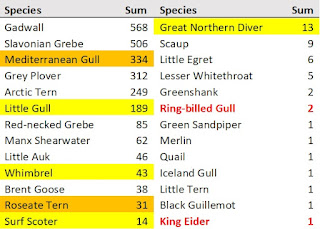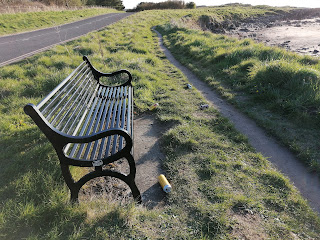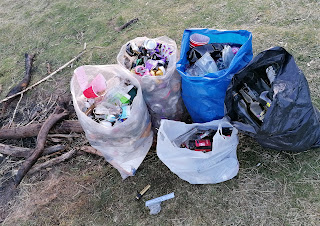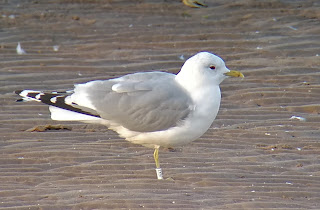 This is a log of the more interesting species seen and heard in, and flying over, a suburban garden on Woodside Road, Banchory, Kincardineshire, Scotland (map). The garden is in an area of detached housing adjacent to terraced council housing. At the time of most of the records listed the nearest open farmland was about 100m to the north-west (but it has since receded to over 1km), and the nearest "wood" was a conifer plantation only just beyond that. The nearest open water is at the Loch of Leys and the River Dee, approximately 1 mile to the north and half a mile to the south respectively.
This is a log of the more interesting species seen and heard in, and flying over, a suburban garden on Woodside Road, Banchory, Kincardineshire, Scotland (map). The garden is in an area of detached housing adjacent to terraced council housing. At the time of most of the records listed the nearest open farmland was about 100m to the north-west (but it has since receded to over 1km), and the nearest "wood" was a conifer plantation only just beyond that. The nearest open water is at the Loch of Leys and the River Dee, approximately 1 mile to the north and half a mile to the south respectively.Detailed records (Excel spreadsheet)
2024
More Red Kite sightings, this one was soaring over Woodside Terrace on 28 January, attracted limited interest from gulls and corvids which are presumably very familiar with it. Such a delight to see there, a 6 kite weekend.
2023
Another year another Waxwing, one flew while I was working in the garden on 11 November.
Red Admirals feeding on falled pears, 12 October, many of them over recent days.
Red Kite now regular over garden, seen by father, 12 April, and now "often daily".
2022
7 Waxwings in flight low over on afternoon 26 November, while helping parents with a bonfire, quite likely more in area as not seen perched, Fieldfare also present at apple trees. Happy memories of seeing Waxwings regularly in years gone by (1985-95 blog). From kitchen window view of an old Magpie nest (this species recorded only once in 1980s, still scarce 1990s, now resident and common).
2021
Tree Sparrows still resident, 5 May, a new colonist in recent years - no records by me anywhere in neighbourhood when resident c. 1980-1990.
2020
Red Kite - third for garden, circling high over on 12 January.
2019
Red Kite - second for garden, circling low over on 16 January.
2018
Tree Sparrows in garden 18 August - first recorded occurence.
2015
Red-letter day for parents with a Red Kite thermalling over, 29 March (first record in 48 years!) species number 64.
2010
First update for this garden for a while - Waxwing on bird table today (25/2), though looked in poor shape - presumably struggling to find food after arriving in the last month or so as part of the small late winter influx right down the east coast. Photos:
 Another bird in a garden elsewhere in Grampian is known from colour rings to be a returning bird, as reported on the BTO demog blog, here.Another change from earlier years is that Magpie is now regular in the garden.
Another bird in a garden elsewhere in Grampian is known from colour rings to be a returning bird, as reported on the BTO demog blog, here.Another change from earlier years is that Magpie is now regular in the garden.
2005
50 Waxwings were again present on 28 March.
In week of 27 February all four thrushes were feeding in the garden (Redwing, Fieldfare, Song Thrush & Blackbird). The Fieldfare was coming to bread on a daily basis and was seen on the bird table on 2 March when snow was heaviest. It is much more able to hold its own with the resident Blackbirds which are vigorously defending "their" food source, and probably pretty annoyed about these various intruders. The Redwing, apparently shyer, spent more time skulking under the hedge, perhaps hoping to pick up scraps left by the larger thrushes.
Waxwings were back at the end of February, with 20+ seen 25-27 February, but a second-hand report of "200" up the road.
On 23 February a Redwing was present in the garden squabbling with Blackbird for scraps of bread under the bird table and in flight (and coming off worst). Snow was lying at the time. This behaviour may be unusual in the UK, though it seems to be perfectly normal for Iceland.
36 Waxwings showed up in the last week of January, including eight colour-ringed birds - all ringed locally by the Grampian Ringing Group, in Aberdeen (4), Aboyne (3) and Inverurie (1). All of the Aberdeen-ringed birds had also been seen subsequently in other places on Deeside, i.e. Aboyne (3) and Westhill (1). All but the Inverurie bird had been ringed on or after 24 December 2004.
Note on local Waxwings
These records prompted me to make a review of our Waxwing records in NE Banchory between 1985 and 2005 (birds also occurred in earlier years but I made no systematic records). A total of over 500 birds-days were recorded distributed over 14 out of the 21 years.
Strong regional correlation is shown with over 10 birds logged in Banchory in every year when peak flock size exceeded 100 in the North-East Scotland Bird Report (NESBR) region whilst in every year with regional peak flock size was below 10 no birds were seen. In the other years (10-100 peak flock size regionally) normally 1-10 birds were seen in Banchory. The ratio of local to regional peak flock size is fairly consistent at around 15%.
Most birds have occurred in Banchory in December with a linear decrease through to April (latest record 23 April 1985). No birds have been seen in October whilst birds arrived in November for the first time in 2004.
Birds have most often been found feeding on cotoneaster berries (frequency 65%), with gean, rowan, apples, hawthorn and rosehip visited in decreasing frequency. Rowan may actually be preferred but berries tend to be exhausted by the time the birds arrive, as are geans (cherries). Amongst the cotoneaster varieties, Cot. bullatus seems to be most favoured, followed by the taller Cot. simondsii and the hedge-forming Cot. horizontalis. The latter is the most common in the area, mainly on Raemoir Road, and has normally been the major food source exploited.
Study data is summarised in this linked spreadsheet.
2004
Herring Gulls, which in earlier years were an abundant visitor passing overhead to the local refuse dump, are now much reduced in numbers. An analysis of records from 1984 to date has shown a reduction to less than a quarter of the former population.
2003
Magpie again on 24 December. 2 Mallard over the same day.
2002
A Magpie was present during week of 17 November - confirming increased presence.
A couple of Treecreepers on our ancient pear tree on 17 September.
2001
Hooded Crow (or close lookalike) nearby on 22 December.
2000
4 Waxwings on 27 December.
1999
Male Chaffinch observed tapping for long periods on house/garage windows from early March through into May, presumably in aggression towards its reflection. Placement of a Snowy Owl picture in the relevant window detered it for 4 days, but tapping subsequently resumed at a reduced intensity.
1998
2 late Swifts in last week of August.
1997
2 Waxwings late March/early April.
1996
A Magpie was seen again at Christmas (all sightings up to this point being 23/12/84, 22/12/90, 23/12/93, 28/12/94, 26/12/96)
A female Blackcap was present end of March/early April. Common Buzzards were seen regularly soaring to the north in early April. A pair of Goosander flew N on 6 April (3rd record).
1995
Male Blackcap and 30 Fieldfare were present in late December.
1994
Hooded Crow recorded again on 26 December.
A male Blackcap was present in February.
1993
First record of Hooded Crow for the garden with a single S on 27 December - species number 63 [PS - hybrid not excluded, but an obvious bird].
1992
Five years after the breeding record, a Goldcrest was singing in the sitka spruce again on 19 April.
1991
Long-tailed Tits and Waxwings (17) were again present in December
A Tawny Owl was heard on 27 March - species number 62.
1990
Over 100 Pied Wagtails were seen circling over a presumed roost site.
The second Spotted Flycatcher for the garden was present on 4 September, just 2 calendar days later than first sighting in 1987.
A Common Buzzard was seen on 28 March - first for garden, species number 61 - and three were seen displaying on 5 April. A pair of Lesser Redpolls were also present end of March/early April. Buzzards and Lesser Redpolls were still present in July.
1989
Long-tailed Tits were seen in December and 300 thrushes (Fieldfare and Redwing) passed over on 18 December.
2 Goosanders overhead on 6 October (2nd record).
Male Lesser Redpoll in song during July - first record, species number 60.
3 Reed Buntings present end of March/early April first record, species number 59.
1700 Rooks and Jackdaws were seen in a roost flock during January.
1988
Golden Plovers were heard calling overhead during the night on 3 October (the day before I left to start university) first record, species number 58.
2 Goosanders circled over the garden on 5 September first record, species number 57.
Migrant Meadow Pipits were seen on 12 occasions between 24 July and 21 September.
A male Brambling was seen on 22 March, first record, species number 56, and Curlews were seen flying N on 24 March.
1987
A Spotted Flycatcher was present on 2 September first record, species number 55.
Migrant Curlews were sighted high overhead in July and both male and female Common Whitethroat in August.
A Yellowhammer was perched in our birch tree on 4 May - first record, species number 54.
Goldcrests bred in a tall Sitka Spruce tree in our neighbour's garden, being seen first on 26 February and last on 20 July. These were the first individuals of this species ever seen in the garden!
A Lapwing flew N on 14 March and Waxwings were present on 20 March.
A male Blackcap was seen in January, February and March.
1986
Between October and December 8 flocks of Greylag or Pinkfoot geese were sighted.
Migrant Curlews were seen moving south high overhead, the first being 11 birds on 28 June.
Swallows bred in a neighbour's porch and despite attentions of local cats a single bird fledged on 20 July. Willow Warblers were seen regularly with up to 8 birds in the garden on 7 August, when a Common Whitethroat was also present. 3 broods of young House Sparrows fledged as last year (c. 15 May, 27 June and 6 August).
Adult Cuckoo seen on 27 June.
A lost female Pheasant was observed walking down the road behind the house on 23 March.
Up to 8 Waxwings were present in January, February and March and on 15 March we watched them drinking from gutter above our back door while eating breakfast.
1985
A party of up to 15 Long-tailed Tits visited the garden at end of November and twice in early December.
30 Siskin were present on 18 September.
House Sparrows had a good breeding season with 3 broods fledged (c. 27 May, 12 July, 18 August). Blackbirds were also very successful with up to 35 individuals in the garden. Up to three Willow Warblers were also seen in early August.
Single Waxwing seen on 15 January and 1st year male Blackcap on 2 February.
1984
Magpie S on 23 December - the only individual seen during 1980's though birds present on farmland c. 1 mile to N.
1978
Active Blackbird nest in quince bush beside our front door, 13 May.
1976
Active Mistle Thrush nest in pear tree outside my bedroom window, 9 May.
[1967 - parents moved to house on Woodside Road.]






















































